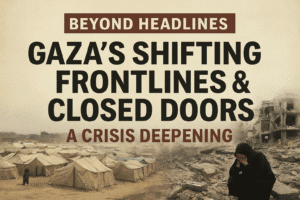Beyond Headlines: Gaza’s Shifting Frontlines & Closed Doors – A Crisis Deepening
Israel forces Gaza City’s civilians south, promising “safe zones” while preparing a major offensive against Hamas. Simultaneously, the US abruptly halts visitor visas for Gazans, devastatingly blocking critically ill patients from accessing lifesaving medical treatment abroad. This compounds a dire humanitarian crisis: severe malnutrition stalks nearly 12,000 young children, contradicting Israeli denials of starvation. The relocation plan raises profound fears, as past “safe zones” faced bombardment and Rafah is perilously overcrowded.
Tragically, 20-year-old Marah Abu Zuhri died days after evacuation to Italy, highlighting the desperate state of Gaza’s health system and the fragility of escapees. Amidst stalled ceasefire talks and intensifying Israeli operations near Gaza City, civilians face escalating displacement, severed lifelines, and deepening catastrophe with dwindling safe havens or avenues for desperately needed care.

Beyond Headlines: Gaza’s Shifting Frontlines & Closed Doors – A Crisis Deepening
The already desperate humanitarian situation in Gaza faces alarming new developments as Israel announces a significant relocation plan and the US abruptly halts visitor visas for Palestinians from the territory, further constricting escape routes for the critically ill.
- Forced Exodus: “Safe Zones” in the South?
- The Plan: Israel’s military announced it will begin relocating Gaza residents from northern combat zones to designated areas in the south starting Sunday, providing tents and shelter equipment via the Kerem Shalom crossing (inspected by Israel, distributed by UN/agencies).
- The Target: Prime Minister Netanyahu framed this as evacuating civilians from Gaza City – labeled Hamas’s “last stronghold” – ahead of an impending major offensive. He described the southern areas as “safe zones.”
- The Questions & Fears:
- Scale: Where exactly in the south? Is Rafah (already severely overcrowded and bombarded) the destination? How will up to a million people be moved and accommodated safely?
- Safety: Previous Israeli-designated “safe zones” have been repeatedly struck, raising grave doubts about their actual safety. International organizations and displaced Gazans themselves question the viability of this plan amidst ongoing bombardment.
- Humanitarian Access: Can aid agencies, already stretched beyond capacity, effectively distribute shelter and sustain life for hundreds of thousands more displaced in the south? The UN reports nearly 12,000 children under five acutely malnourished, with over 2,500 in severe, life-threatening condition – figures contradicting Netanyahu’s recent denial of starvation.
- A Lifeline Severed: US Halts Visitor Visas
- The Decision: In a move with immediate humanitarian consequences, the US State Department suspended all visitor visas (B1/B2) for individuals from Gaza pending a “full and thorough review.”
- The Impact:
- Medical Evacuations Blocked: This directly halts programs bringing critically ill and wounded Gazans, especially children, to the US for lifesaving treatment unavailable in the decimated enclave. The Palestine Children’s Relief Fund called the decision “devastating and irreversible” for their mission.
- Contradiction & Context: While the US cited a routine review, the timing follows inflammatory claims by far-right activists about Palestinian “refugees” entering the US, which sparked Republican backlash. This suspension starkly contrasts with the over 3,800 such visas issued to Palestinians in 2025 prior to the halt, including 640 in May alone – many likely for medical purposes.
- Shrinking Options: With neighboring Egypt’s border largely closed and now the US pathway blocked, avenues for the most vulnerable to seek urgent medical care narrow dramatically.
- A Tragic Symbol: Evacuated, But Too Late The precariousness of medical evacuations was tragically underscored by the death of Marah Abu Zuhri, 20, just days after arriving in Italy. Severely deteriorated, she was part of Italy’s largest medical evacuation yet (14th since January). Her death after cardiac arrest highlights the extreme fragility of patients finally escaping Gaza’s collapsing health system, often only after prolonged suffering and delay.
- Military Reality & Stalemate
- While Defence Minister Katz stated plans for the Gaza City offensive are “still being formulated,” Israeli forces have already intensified operations in outskirts like Zeitoun and Shejaia, employing heavy aerial and tank fire, destroying homes, and targeting tunnels and militants.
- Ceasefire and hostage release negotiations remain deadlocked, despite ongoing efforts by Egypt and Qatar. Protests demanding a deal and an end to the war are planned across Israel.
The Big Picture: A Deepening Abyss These developments paint a grim picture:
- Mass Displacement Under Duress: The planned relocation risks compounding Gaza’s displacement crisis, pushing more people into areas with questionable safety and insufficient resources.
- “Safe Zones” Under Scrutiny: Without concrete guarantees and independent oversight, the term “safe zone” rings hollow for Gazans who have repeatedly fled under fire.
- Humanitarian Catastrophe Worsening: Severe malnutrition, lack of medical care, and the blocking of medical visas create a perfect storm of suffering, disproportionately affecting children.
- Closed Doors: The US visa suspension cuts a critical lifeline for the most vulnerable, reflecting a troubling politicization of humanitarian access.
- Military Escalation Looms: The imminent offensive in Gaza City threatens renewed intense urban combat with devastating consequences for civilians trapped or forced to flee again.
The situation demands urgent international attention not just to the mechanics of relocation or visa policies, but to the fundamental questions of civilian protection, unimpeded humanitarian access, and a viable political solution to end the cycle of violence and suffering. The lives of Gaza’s 2.2 million people hang in an increasingly precarious balance.
You must be logged in to post a comment.